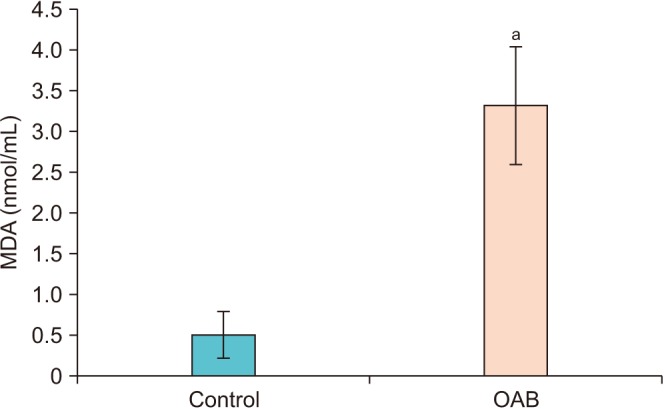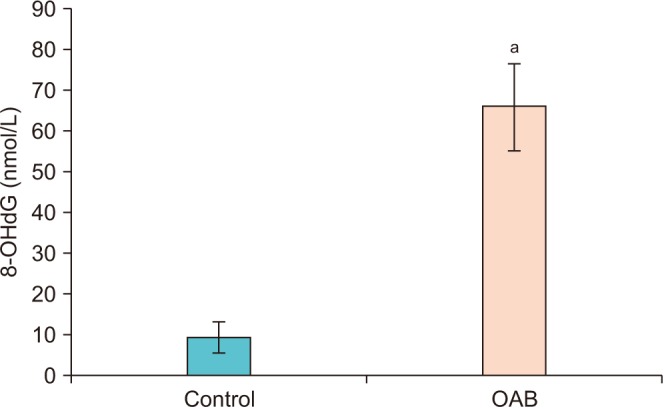1. Abrams P, Cardozo L, Fall M, Griffiths D, Rosier P, Ulmsten U, et al. The standardisation of terminology of lower urinary tract function: report from the Standardisation Sub-committee of the International Continence Society. Neurourol Urodyn. 2002; 21:167–178. PMID:
11857671.

2. Stewart WF, Van Rooyen JB, Cundiff GW, Abrams P, Herzog AR, Corey R, et al. Prevalence and burden of overactive bladder in the United States. World J Urol. 2003; 20:327–336. PMID:
12811491.

3. Steers WD. Pathophysiology of overactive bladder and urge urinary incontinence. Rev Urol. 2002; 4(Suppl 4):S7–S18. PMID:
16986023.
4. Nitti VW, Blaivas JG. Urinary incontinence: epidemiology, pathophysiology, evaluation, and management overview. In : Wein AJ, Kavoussi LR, Novick AC, Partin AW, Peters CA, editors. Campbell-Walsh urology. 9th ed. Philadelphia: Saunders Elsevier;2007.
5. Abrams P, Cardozo L, Khoury S, Wein A. Incontinence: The Third WHO International Consultation on Incontinence. Plymouth (England): Health Publications;2005. p. 26–32.
6. Nielsen F, Mikkelsen BB, Nielsen JB, Andersen HR, Grandjean P. Plasma malondialdehyde as biomarker for oxidative stress: reference interval and effects of life-style factors. Clin Chem. 1997; 43:1209–1214. PMID:
9216458.

7. Özcan O, Erdal H, Çakırca G, Yönden Z. Oxidative stress and its impacts on intracellular lipids, proteins and DNA. J Clin Exp Invest. 2015; 6:331–336.

8. De Martinis BS, de Lourdes Pires Bianchi M. Methodology for urinary 8-hydroxy-2′-deoxyguanosine analysis by HPLC with electrochemical detection. Pharmacol Res. 2002; 46:129–131. PMID:
12220951.

9. Dizdaroglu M. Facts about the artifacts in the measurement of oxidative DNA base damage by gas chromatography-mass spectrometry. Free Radic Res. 1998; 29:551–563. PMID:
10098459.

10. Helbock HJ, Beckman KB, Ames BN. 8-Hydroxydeoxyguanosine and 8-hydroxyguanine as biomarkers of oxidative DNA damage. Methods Enzymol. 1999; 300:156–166. PMID:
9919519.

11. Williams GM, Jeffrey AM. Oxidative DNA damage: endogenous and chemically induced. Regul Toxicol Pharmacol. 2000; 32:283–292. PMID:
11162722.

12. Kasai H. Analysis of a form of oxidative DNA damage, 8-Hydroxy-2’ deoxyguanosine, as a marker of celluler cellular oxidative stress during carcinogensis. Mutat Res. 1997; 387:147–163. PMID:
9439711.
13. Ohkawa H, Ohishi N, Yagi K. Assay for lipid peroxides in animal tissues by thiobarbituric acid reaction. Anal Biochem. 1979; 95:351–358. PMID:
36810.

14. Zhao Y, Levin SS, Wein AJ, Levin RM. Correlation of ischemia/reperfusion or partial outlet obstruction-induced spectrin proteolysis by calpain with contractile dysfunction in rabbit bladder. Urology. 1997; 49:293–300. PMID:
9037302.

15. Ouslander JG. Management of overactive bladder. N Engl J Med. 2004; 350:786–799. PMID:
14973214.

16. Teloken C, Caraver F, Weber FA, Teloken PE, Moraes JF, Sogari PR, et al. Overactive bladder: prevalence and implications in Brazil. Eur Urol. 2006; 49:1087–1092. PMID:
16497431.

17. Dambros M, Dambros MC, Lorenzetti F, Dassen EL, van Koeveringe GA. The use of hypochlorous acid as a model for investigating bladder overactivity. Int Braz J Urol. 2014; 40:408–413. PMID:
25010308.

18. Huang YB, Lin MW, Chao Y, Huang CT, Tsai YH, Wu PC. Anti-oxidant activity and attenuation of bladder hyperactivity by the flavonoid compound kaempferol. Int J Urol. 2014; 21:94–98. PMID:
23634640.

19. García JJ, Reiter RJ, Guerrero JM, Escames G, Yu BP, Oh CS, et al. Melatonin prevents changes in microsomal membrane fluidity during induced lipid peroxidation. FEBS Lett. 1997; 408:297–300. PMID:
9188780.
20. Bisogni S, Ferreira FT, Amstalden Neto A, Chiarelli LO, Ortiz V. Influence of oxidative stress on inducing micturition dysfunction following chronic infravesical obstruction and the protective role of an antioxidant diet: association of in vivo and in vitro studies in rats. Int Braz J Urol. 2012; 38:552–560. PMID:
22951166.
21. Alexandre EC, Calmasini FB, de Oliveira MG, Silva FH, da Silva CPV, André DM, et al. Chronic treatment with resveratrol improves overactive bladder in obese mice via antioxidant activity. Eur J Pharmacol. 2016; 788:29–36. PMID:
27316789.

22. Topol T, Schuler C, Leggett RE, Hydery T, Benyamin S, Levin RM. Effect of solifenacin plus and minus antioxidant supplements on the response to experimental outlet obstruction and overactive bladder dysfunction in rabbits: part 2. Urol Sci. 2011; 22:141–146.
23. Kulaksız G, Sancar A. Nucleotide excision repair and cancer. Turk J Biochem. 2007; 32:104–111.
24. Cooke MS, Evans MD, Dizdaroglu M, Lunec J. Oxidative DNA damage: mechanisms, mutation, and disease. FASEB J. 2003; 17:1195–1214. PMID:
12832285.

25. Pilger A, Rüdiger HW. 8-Hydroxy-2′-deoxyguanosine as a marker of oxidative DNA damage related to occupational and environmental exposures. Int Arch Occup Environ Health. 2006; 80:1–15. PMID:
16685565.

26. Yang JH, Siroky MB, Yalla SV, Azadzoi KM. Mitochondrial stress and activation of PI3K and Akt survival pathway in bladder ischemia. Res Rep Urol. 2017; 9:93–100. PMID:
28652996.

27. Nocchi L, Daly DM, Chapple C, Grundy D. Induction of oxidative stress causes functional alterations in mouse urothelium via a TRPM8-mediated mechanism: implications for aging. Aging Cell. 2014; 13:540–550. PMID:
24593692.

28. Matsui T, Oka M, Fukui T, Tanaka M, Oyama T, Sagawa K, et al. Suppression of bladder overactivity and oxidative stress by the phytotherapeutic agent, Eviprostat, in a rat model of atherosclerosis-induced chronic bladder ischemia. Int J Urol. 2012; 19:669–675. PMID:
22458726.







 PDF
PDF ePub
ePub Citation
Citation Print
Print





 XML Download
XML Download